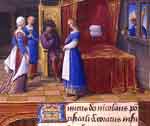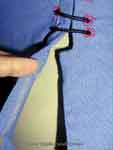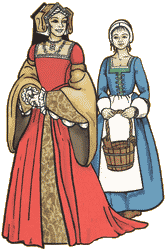 |
 |
 |
 |
 |
 |
 |
 |
| Complete Photo Gallery Here |
 If
you are looking to make your own Henrician/Tudor working class outfit,
I highly recommend using Margo
Anderson's Tudor Lady's Wardrobe pattern, with historical notes
researched by me. If
you are looking to make your own Henrician/Tudor working class outfit,
I highly recommend using Margo
Anderson's Tudor Lady's Wardrobe pattern, with historical notes
researched by me. |
Started: June 8, 2008
Ended: September 1, 2008
This is a periwinkle blue linen kirtle, based in general on the early working women's kirtle style of the early 1500s. This style actually spans from the end of the 1400s, and stays for some time in the 1500s. But I've focused on images of the early 1500s for this kirtle.
The fabric is 100% linen to provide a cool outfit to wear at our very hot summer events. The bodice and skirt pattern I used came from Margo Anderson's Lady's Wardrobe patterns (underskirt and bodice). The sleeve pattern is my own creation.
Please note that photos of me wearing this kirtle in a blackworked smock, the smock is what I had available to wear. It is too fancy (goes with my court dress) and is not what a working woman would wear.
This simple kirtle is my first major foray into a specific hand sewing technique. Actually, I am using two techniques that others before me have outlined very well.
The first is the method where the outer fabric is wed to its flatlining, creating a firmer bodice that can actually support me very well without addtional boning or fabrics. It is a method that a woman known to me as Peronel has on her web site in full color photos here. I folded over the edge of the fashion fabric over the interlining, twice, then hem stitched the fabric in place. This leaves no visible seam on the outside. I only used cotton drill, which is a light-medium weight twill fabric, for the interlining.
She also added a lining to her bodice, which I did not do, as I wanted as few layers as possible. Another change from her method shown, is that I chose not to add any boning whatsoever to my bodice, which I found out from her, is something she has also recently opted to do as seen here.
I then attached the various flatlined parts together using a sewing method outlined by Laura Mellin (1). She nicely shows in full color photos The Elizabethan Seam on her own web site. Simply, this is a fine whip stitch along the edges of the two finished edges. Following her example, I have sewn together the kirtle bodice parts, the attachment of the skirt to the bodice, and the sleeves to the bodice.
The skirt was edge finished with a machine serger/overlock, then sewn together by machine - partly for speed and mainly because linen frays easily. The hem was finished by turning up twice, then sewn by hand using a hem stitch. The top of the skirt was turned down at the seam allowance, and whip stitched to the bodice by hand.
The skirt front is fairly smooth, with one box pleat at each side to take up extra fabric. I used box pleats for the rest of the kirtle skirt in the sides and back. It is a nice and simple pleating method that gives a nice drape. On one side of the front opening skirt slit (needed to get the garment on over the head), I allowed one side of the skirt to extend past the front opening by an inch, which underlaps the other side. This allows the slit to visually remain hidden when closed. I did not leave a pocket slit at this time, tho I might put one in later.
The sleeves are unlined to keep cooler. To finish the edges, I turned the seam allowance under twice, holding down the edge with a running stitch. The sides were then joined using first a running stitch, then finished as a flat-felled seam, mostly using the running stitch. These seams are fully visible on the outside.
I plan on wearing this kirtle as regular camp clothing on our hot summer days, and even as everyday wear as it is surprisingly very comfortable. It should also prove versatile, as it provides the base layer for any period appropriate style of gown, can be paired with a variety of sleeves, or worn with a simple apron ready to do any amount of manual labor.
The complete photo gallery will take you to an offsite location in a new browser window. There are images, along with more info, there that show some of the construction details, for those interested. Additional info can be found in my LiveJournal dress diary entries.
1. Aka the Extreme Costumer, and known in the SCA as Mistress Isobel Gildingwater of Ditchingham.
Home
Creative Blog
Kimiko Small Designs
Joan Silvertoppe's SCA Resumé
Warderobe Accounts
Brodyworke Accounts
Scriptor Arts Folium
Tudor Research
Workshops & Articles
Inspiration Gallery
Largesse
Favorite Links
About Me
Contact Me
http://www.kimiko1.com
Entire website, graphics, and text (unless otherwise stated)
© 2003-2013 Kimiko Small, All Rights Reserved


